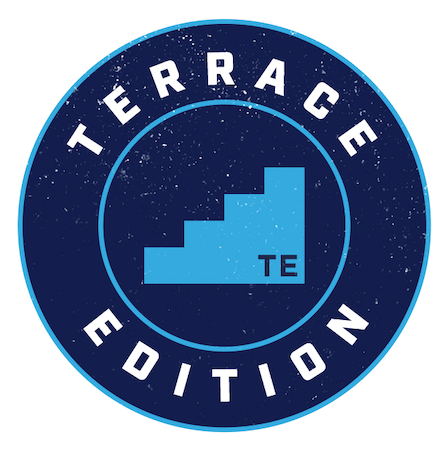The Far Corner

Words: Mike Bayly
Images: Mike Bayly
On Saturday, I made the 12-hour round journey to Raith Rovers’ Stark’s Park in Kirkcaldy, Scotland.
During the trip, I questioned (not for the first time) my life choices. Was half a day spent on stifling public transport for the sake of two hours at a random football match a constructive use of my time? I hastily concluded it was.
One of my primary motivations for visiting grounds is architecture. Specifically, architecture from the Victorian and Edwardian era. Given the ever-dwindling stock of these ageing football structures, it is incumbent on me to enjoy the game’s heritage while I can, regardless of daunting logistics.
Formed in 1883, Raith Rovers moved to Stark’s Park in 1891. Ostensibly a modern- looking stadium on approach, Stark’s Park’s pièce de resistance is the 100-year-old main stand in the south-east corner, named in honour of former chairman, Turnbull Hutton.
©Mike Bayly/ Terrace Edition. Raith Rovers vs Partick Thistle.
Due to physical constraints (the ground is hemmed in by a railway line on the west side and a residential road on the east side) the L-shaped stand is crowbarred into a bend on Pratt Street, running less than half the length of the pitch.
It is an enclosure shrouded in history and to a certain extent, myth.
The design of Raith’s grand centennial is frequently accredited to Archibald Leitch. Born in Glasgow in 1865, Leitch was the pre-eminent football ground designer of the late 19th and early 20th century, responsible for some of the most visually arresting stadia in Britian.
Most of his original commissions have long-since vanished, although a few remain, notably at Everton’s Goodison Park, Fulham’s Craven Cottage and Rangers’ Ibrox.
©Mike Bayly/ Terrace Edition. Raith Rovers vs Partick Thistle.
While there are design similarities, there is little evidence to suggest the main stand at Stark’s Park was a Leitch creation. There is no reference to it in Simon Inglis’ authoritative Engineering Archie, or his earlier work Football Grounds of Britain, other than mention of a “Leitch-Style gable on the roof bearing the initials RRFC” suggesting, at best, a pastiche.
Consulting local archives, a lengthy piece in the Dundee Courier from April 1922, outline Rovers’ plans to construct a new grandstand, pavilion and offices at a cost of £10,000, following the club’s full acquisition of the ground. The architects are detailed as William Williamson and Geroge Deas of Kirkcaldy.
Williamson was an accomplished local engineer, responsible for designing some of the town’s most prominent buildings. Later reports advise Lord Novar, Secretary For Scotland, performed the stand’s opening ceremony before a game against Celtic in December 1922.
Aside from the value of historical accuracy, does the identity of the stand’s architects really make a difference? Viewed through a purely aesthetic lens (and forgoing a potential reference to ‘sunshine on Leitch’ on what was a glorious summer’s day in Fife) I’d argue not.
©Mike Bayly/ Terrace Edition. Raith Rovers vs Partick Thistle.
Stark’s Park’s main stand offers a rare glimpse of the early 1900s match-going experience. Granted, the sightlines and creature comforts fall short of contemporary standards, but, to a casual visitor at least, these are perfect imperfections that distinguish it from much of football’s increasingly bland homogenised landscape.
Objectively, it might look an antiquated presence among the stadium’s relatively new stands, but it provides Stark’s Park with tangible ancestry, like multiple generations of a family occupying the same home.
Short of listing status, the long-term future of Britain’s architectural football heritage remains unclear. There inevitably comes a point where sentimentality bows to progress. While there are no plans to replace the main stand at Stark’s Park, there is a wider ongoing upgrade project, including possible installation of safe standing on the largely disused railway side.
Football grounds are in a constant state of flux, but for as long as its oldest structures remain intact, my long journeys into the game’s past will continue.
©Mike Bayly/ Terrace Edition. Raith Rovers vs Partick Thistle.
©Mike Bayly/ Terrace Edition. Raith Rovers vs Partick Thistle.
©Mike Bayly/ Terrace Edition. Raith Rovers vs Partick Thistle.
©Mike Bayly/ Terrace Edition. Raith Rovers vs Partick Thistle.
©Mike Bayly/ Terrace Edition. Raith Rovers vs Partick Thistle.
©Mike Bayly/ Terrace Edition. Raith Rovers vs Partick Thistle.
©Mike Bayly/ Terrace Edition. Raith Rovers vs Partick Thistle.
©Mike Bayly/ Terrace Edition. Raith Rovers vs Partick Thistle.
©Mike Bayly/ Terrace Edition. Raith Rovers vs Partick Thistle.
©Mike Bayly/ Terrace Edition. Raith Rovers vs Partick Thistle.
Mike Bayly is one of Britain’s foremost football landscape photographers. His book “British Football’s Greatest Grounds” is available to buy here
Mike can be found on X and Instagram: @mike_bayly


















